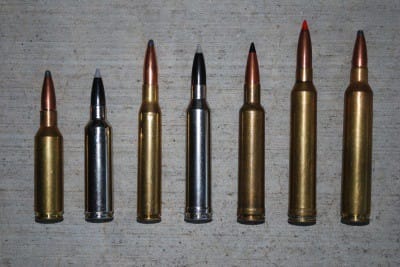
I grew up in what we used to call the magnum craze, the late 1950s and on through the 60s when every new cartridge wore a belt and was called a “magnum.” Some were flops, but this era produced some of our most popular cartridges, including the 7 mm Remington Magnum and .300 Winchester Magnum. Starting in about 1998 I think we went into a second magnum craze. In a brief period we have seen four long Remington Ultra Mags, two short Remington Short Action Ultra Mags; four Winchester Short Magnums and three Winchester Super Short Magnums; and now two Ruger Compact Magnums. All of these are fat-cased unbelted cartridges. Weatherby brought out the huge-cased .30-.378 and .338-.378 Weatherby Magnum, both belted cartridges.
Which succeed and which fail is really up to you, and let’s hope the cream rises to the top. One thing I do believe: All of these new cartridges are extremely well designed, and all do pretty much what their manufacturers say they will do. I have worked with them all on the range, and have done at least a little hunting with most of them. None exactly break new ground in the performance department, although the long-cased RUMs and the two Weatherby magnums are pretty much the fastest in their class.
Most of these new cartridges are about packaging. They duplicate the performance of cartridges we have had for many years, but with shorter, fatter case dimensions they can be housed in shorter, lighter, handier actions. Because of burning efficiencies achieved in the same shorter, fatter cases, generally they can strut their stuff from somewhat shorter barrels.Even for the most long-gone rifle nut it is impossible to love them all equally. Hell, it’s the same with all of our old favorites! Me, I’m a .270 nut and a .30-caliber freak. The 7 mms are great, but they fall right in between—so I’ve never been a big 7 mm fan. All of the new .30s are great. I’ve used the 7 mm RUM a lot, the .300 WSM quite a bit, and I think the new kid on the block, the .300 RCM is cool because it feeds so well. But I have fast .30s in .300 Winchester Magnum, .300 H&H, and .300 Weatherby Magnum, and I don’t see the new cartridges replacing these tried-and-true cartridges, at least not in my orisons.

My favorite among all the new magnums is the .270 WSM. It doesn’t break new ballistic ground; technically the 65-year-old .270 Weatherby Magnum is just as fast. Except the .270 WSM offers its performance from a shorter action, and does it with a shorter barrel. It is more available than the .270 Weatherby Magnum has ever been. And as much as I love the .270 Winchester, I believe the .270 WSM offers a performance edge that is worth having.
Ammo is available from Federal, Norma, and Winchester, with a good selection of bullets. The actual difference in velocity between it and the .270 Winchester varies greatly with the load, as little as just 100 fps; as much as a whopping 400 fps. The average increase is probably 200 fps. This is only about a 7 percent increase, so while the .270 WSM with an aerodynamic bullet is about as flat-shooting as anything out there (as is the .270 Weatherby), it isn’t really all that much flatter-shooting than the .270 Winchester, certainly not enough improvement to get really excited about. However, the burning efficiency that allows it to do what it does from a fairly tidy case is also conducive to accuracy, as is the shorter and thus more rigid action it can be housed in. I’ve used several .270 WSMs and have owned three, and while I can’t prove it I believe the on-average accuracy is superior to the .270 Winchester.
All the accuracy you can get is useful in the plains and mountains, which is where I think the .270 WSM fits best. But there’s something else. While the trajectory gains are modest, never forget that energy goes up exponentially as velocity increases. So, just for sake of argument, let’s take Federal’s 140-grain Trophy Bonded Bearclaw load in each cartridge. In the .270 Winchester velocity is 2,940 fps for 2,685 foot-pounds of energy. The same bullet in the same company’s .270 WSM load has a muzzle velocity of 3,200 fps, a fairly significant improvement of 260 fps. The energy for this load, at the muzzle, is 3,185 foot-pounds, a nice, neat energy increase of 500 foot-pounds.

This, to me, is the most significant benefit of the .270 WSM over the good old .270. Increase in recoil is present but acceptable; the .270 WSM is still a mild, easy to shoot cartridge—but it hits noticeably harder. On a lot of animals it doesn’t matter, but on larger game it makes a difference, and I’ve seen it in the field. I’ve used both for elk, and there’s a difference.
I personally wouldn’t take a .270 Winchester to hunt the big Asian argalis. Most hunters use fast .30s, a few use 7 mms. The first time I hunted Marco Polo sheep I used my big, heavy, 8 mm Remington Magnum. It worked great, but the second time I took a .270 WSM: More energy, slightly flatter trajectory, better wind resistance (because of reduced flight time). I used the .270 WSM in Mongolia for everything from small gazelle to big ibex. I took one to the Yukon for a Stone sheep, and with the sheep in the salt I hoped to use it on a grizzly. That didn’t happen, but, with a tough Barnes Triple Shock, I think I was ready.

I was shooting one just today, getting it ready for a fall hunt in Europe. If things go well it should account for a moose in Sweden, then an ibex and a chamois in Spain. Between the three you have large big game, small big game, tough big game, and shooting conditions that might vary from quite close to very far. There are many cartridges that could handle such a variety of situations. I’m taking a .270 WSM because it’s effective without a lot of recoil—and, perhaps most importantly, because I believe in it. It isn’t my place to say it’s the best of the new magnums—it may well not be. But it is my favorite!



